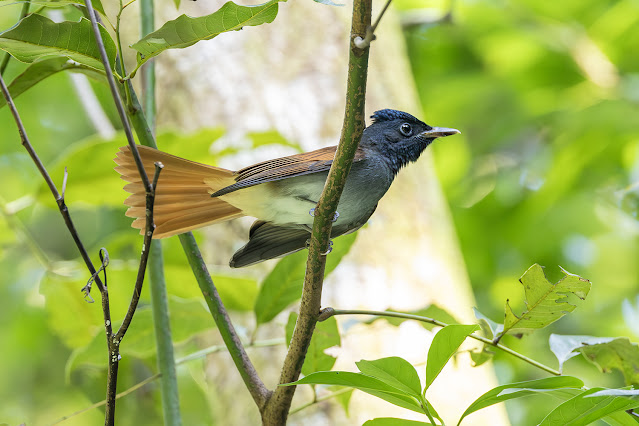Appearance of Amur Paradise Flycatchers officially marks the end of our quiet summer. A short walk at Tai Po Kau Nature Reserve last month yielded two of these energetic birds, both busy looking for insects and fighting each other. These quick moving birds were perfect subject to test out my newly acquired Canon EOS R6 mk II, which seems to be doing its job fairly well, together with the RF 100-500mm f/4.5-7.1 lens, was a very light and manageable setup in the forest. In the same bird wave I also found an Eastern Crowned Warbler, another early migrant.
 |
| Amur Paradise Flycatcher - first of our autumn migrants |
Otherwise, it was still relatively quiet, with mostly local residents seen, only Huet's Fulvettas and Mountain Bulbuls were cooperative enough for me to photograph.
 |
| Huet's Fulvetta |
 |
| Mountain Bulbul |
While there are no buntings to attract during the summer in the paddyfields, hundreds of Scaly-breasted Munias take advantage of the rice, they are always good models especially when seen up close, such as this one. I didn't really bother looking for breeding Greater Painted Snipes anywhere, but its a species always lovely to see.
 |
| Scaly-breasted Munia |
 |
| Greater Painted Snipe |
Deep Bay Area is receiving more autumn migrants now such as Pin-tailed Snipes and various waders. Kentish and Siberian Sand Plovers are both returning, as well as Long-toed and Temminck's Stints. I expect more will soon be following.
 |
| Pin-tailed Snipe |
 |
| Kentish Plover |
 |
| Siberian Sand Plover |
 |
| Long-toed Stint |
 |
| Temminck's Stint |
Eastern Yellow Wagtails are also returning once more, they often migrate in flocks and now outnumbering our local White Wagtails.
 |
| Eastern Yellow Wagtail |
Last week we just experienced one of the strongest typhoon since 2018, typhoon Saola strengthen with centre wind speed reaching over 230km/h at its peak. It barely weakened as it reached within 50km to Hong Kong, luckily it was a relatively compact typhoon, we only experienced the worst of the winds for a few hours before it slowly moved towards Macau. The strength of the wind was clearly visible during the aftermath, as we saw numerous trees collapsed, even this sail boat got toppled during the storm.
 |
| Damage from Typhoon Saola |
Hoiling and I decided to head out towards the seaside once the wind died down the next day, hoping to see if any birds had been blown into Plover Cove, as soon as we got off our car we saw terns flying around in the harbour, mostly Common Terns foraging amongst the boats. There were also plenty of Whiskered Tern along with them.
 |
| Common Tern |
 |
| Whiskered Tern |
I was pleasantly surprised by a few Aleutian Terns mixed in with the Common Terns, they are considerably scarcer than Common Terns and I only usually see them during pelagic trips! I was even more surprised when I saw some Greater Crested Terns, these large terns are usually seen much further out at sea, no doubt the typhoon brought them this far into the cove.
 |
| Aleutian Tern |
 |
| Greater Crested Tern |
For the next hour or so we continued to count the passing terns, I am sure it was up to way over a hundred terns coming through, in the end we counted up to 8 species of terns, other than those previously mentioned, we also added Black-naped, Bridled, Little and Gull-billed Terns. Before we left we also saw a flock of Red-necked Phalarope flying past. Certainly made for an interesting post typhoon activity!
 |
| Black-naped Tern |
 |
| Red-necked Phalarope |



























No comments:
Post a Comment